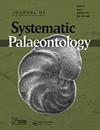性二型盾形鱼的再描述(中国中三叠纪):分类学意义和系统发育关系
IF 2.2
2区 地球科学
Q3 EVOLUTIONARY BIOLOGY
引用次数: 2
摘要
乌海鱼是一种产于中国南部贵州兴义拉丁岛的小型鱼类,几年前被命名为胸鳍鱼科中最原始的物种(三叠纪“飞行”鱼类,欧亚分布)。然而,这一假设受到了质疑,因为乌海鱼也与Peltopeuridae有共同的特征。根据新的标本,加上对先前研究的标本的修订,以及盾翅目和胸蕨目的成员,对乌海鱼进行了详细的形态学重新描述,并根据137个特征和54个分类群进行了系统发育分析,检验了它们之间的关系。结果表明,乌鱼是一个分支的成员,在这里被解释为新的胸科超科,其中包含乌鱼科家族。nov.(Wuhaichthys+Peripeltopleurus)和胸鳍鱼科,是Peltopeuriformes中非单系Peltopeuridae的姐妹分类单元。胸科超科。nov.受到许多突触形态的有力支持(例如,额骨(=顶骨)轻微侧向扩张;颞后接触肩胛骨外侧,使其与对应的肩胛骨分离;悬浮体垂直定向;狭窄而深的矩形前孔,垂直定向;在整个上颌突中与上颌骨后缘缝合的前牙;大多数属胸鳍增大;和深分叉的下尾鳍)。虽然胸翼科是单系的,但它的一个属胸翼科却不是。因此,对胸翼科的内容进行了重新评估,现在包括胸翼目、巨翼目、Potanichthys comb。nov.和Italopterus gen.nov.Wuhaichthydidae有一个独特的特征组合,结果证实它是胸翼类,但不是胸翼类。乌海鱼的特征与理解胸翼类的分类学和系统学有关,尤其是胸鳍、腹鳍和尾鳍下叶的进化形态修饰,这是这些鱼类的一些主要特征。http://zoobank.org/urn:lsid:zoobank.org:pub:8FFF4E8D-780C-4DFB-B0C8-7E27D912CE8E本文章由计算机程序翻译,如有差异,请以英文原文为准。
Re-description of the sexually dimorphic peltopleuriform fish Wushaichthys exquisitus (Middle Triassic, China): taxonomic implications and phylogenetic relationships
Wushaichthys exquisitus, a small fish from the Ladinian of Xingyi, Guizhou Province, southern China, was named a few years ago and interpreted as the most primitive species in the Thoracopteridae (Triassic ‘flying’ fishes with a Euro-Asian distribution). However, this hypothesis was questioned, because Wushaichthys also shares features with Peltopleuridae. A detailed morphological re-description of Wushaichthys was conducted based on new specimens, plus a revision of previously studied ones, as well as of members of Peripeltopleurus and thoracopterids, and their relationships were tested with a phylogenetic analysis based on 137 characters and 54 taxa. The results suggest that Wushaichthys is a member of a clade that is interpreted here as the new superfamily Thoracopteroidea, which contains Wushaichthyidae fam. nov. (Wushaichthys + Peripeltopleurus) and Thoracopteridae and is the sister taxon of the non-monophyletic Peltopleuridae among Peltopleuriformes. Thoracopteroidea superfam. nov. is strongly supported by numerous synapomorphies (e.g. frontal (= parietal) bone slightly expanded laterally; posttemporal contacts the extrascapular anterolaterally separating it from its counterpart; suspensorium is vertically oriented; narrow and deep rectangular preopercle, vertically oriented; preopercle sutured with the rear edge of the maxilla throughout the maxillary process; enlarged pectoral fins in most genera; and deeply forked hypocercal caudal fin). Although Thoracopteridae is monophyletic, one of its genera, Thoracopterus, is not. Consequently, the content of Thoracopteridae was re-evaluated and now includes Thoracopterus, Gigantopterus, Potanichthys comb. nov. and Italopterus gen. nov. Wushaichthyidae is supported by a unique combination of characters, and the results confirm it as a thoracopteroid, but not a thoracopterid. The characters of Wushaichthys are relevant for understanding the taxonomy and systematics of thoracopteroids, especially the evolutionary morphological modifications of the pectoral and pelvic fins and the lower lobe of the caudal fin, which are some of the main characters of these fishes. http://zoobank.org/urn:lsid:zoobank.org:pub:8FFF4E8D-780C-4DFB-B0C8-7E27D912CE8E
求助全文
通过发布文献求助,成功后即可免费获取论文全文。
去求助
来源期刊
CiteScore
5.30
自引率
7.70%
发文量
31
审稿时长
>12 weeks
期刊介绍:
The Journal of Systematic Palaeontology publishes papers that provide novel and impactful results in phylogenetics and systematics and that use these results in ways that significantly advance rigorous analyses of palaeogeography, palaeobiology, functional morphology, palaeoecology or biostratigraphy. Papers dealing with theoretical issues or molecular phylogenetics are also considered if they are of relevance to palaeo-systematists. Contributions that include substantial anatomical descriptions, descriptions of new taxa or taxonomic revisions are welcome, but must also include a substantial systematics component, such as a new phylogeny or a revised higher-level classification. Papers dealing primarily with alpha-taxonomic descriptions, the presentation of new faunal/floristic records or minor revisions to species- or genus-level classifications do not fall within the remit of the journal.

 求助内容:
求助内容: 应助结果提醒方式:
应助结果提醒方式:


